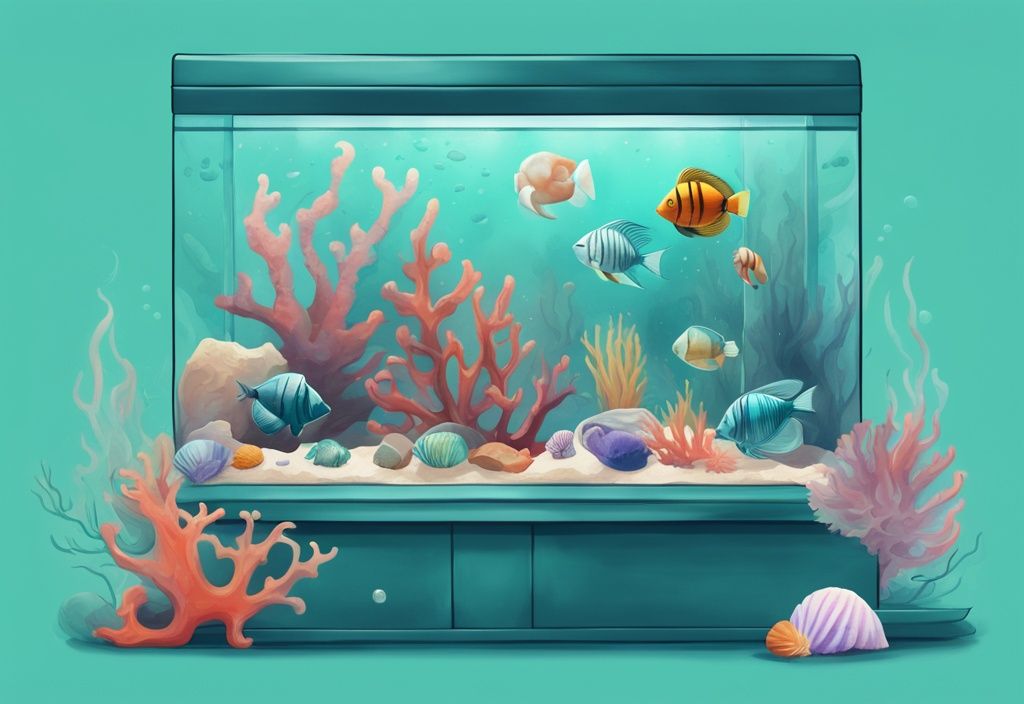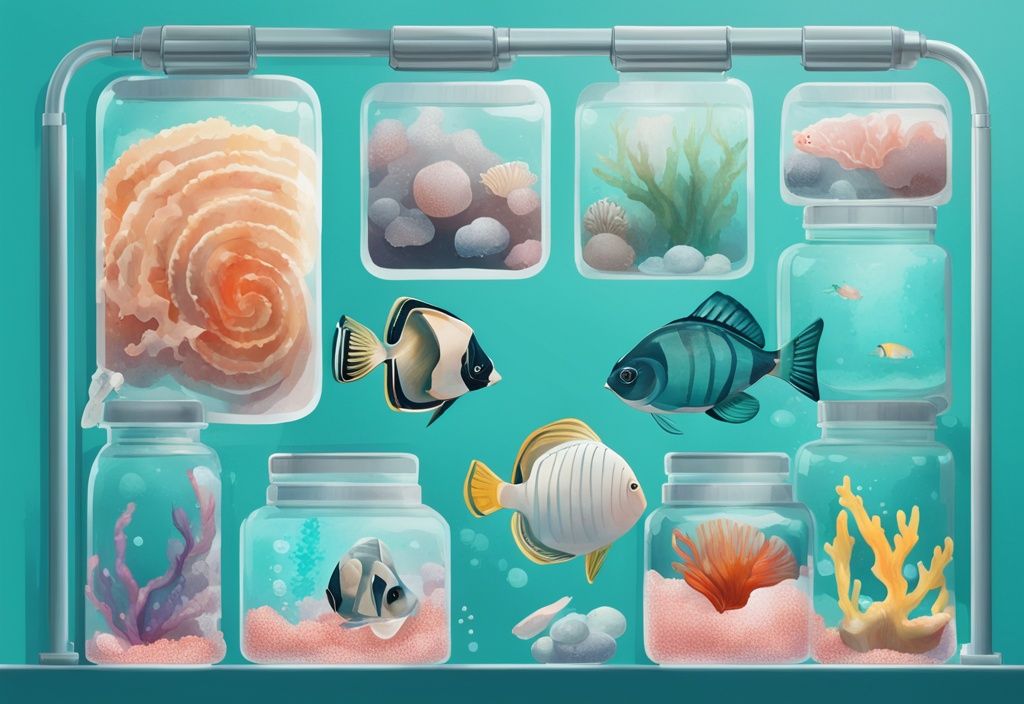Ever wondered why your fish aren’t as vibrant and active as they could be? It could be the levels of Carbonate Hardness (KH) in your aquarium. Understanding and maintaining the right KH levels is critical to creating the perfect aquatic environment for your finned friends. It’s a delicate juggling act I, Dr. Melanie Rivers, have mastered over two decades of marine biology practice and research.
While the concept might sound complex, fear not. I’m here to take you through the nitty-gritty of raising KH in your aquarium without the in-depth science jargon. My goal is to make this as uncomplicated as possible, so every fish owner, whether novice or professional, can easily follow.
By the end of this guide, you’ll not only grasp the importance of KH but also feel confident about handling those pesky pH fluctuations. Ready to dive in and create a thriving aquarium? Let’s get started.
Understanding the Importance of KH in Aquariums
Maintaining the right KH levels, or carbonate hardness, is paramount for any aquarium, and understanding how these parameters interact is essential for a healthy ecosystem. For a deeper dive into the differences between pH, GH, and KH and their impacts on your fish, check out this practical guide for beginners. This section explores the significance of KH and offers practical tips for managing it, ensuring a thriving aquatic environment.
What Exactly is KH?
KH, or carbonate hardness, measures the concentration of carbonates and bicarbonates in water. It’s key to the stability of pH levels within an aquarium. Imagine KH as the alarm system of your aquatic world: it acts as a buffer, shielding your tank from sudden pH swings that could disturb the delicate balance your aquatic friends depend on. For anyone keen to learn how to raise KH in aquarium settings, grasping the concept of KH is essential, as stable KH leads directly to the overall health and well-being of your fish and plants.
Benefits of the Right KH Levels
Achieving the proper KH levels in your aquarium brings numerous rewards. Think of high KH levels as a guardian against rapid pH fluctuations, protecting your fish and other aquatic life from stress and harm. This stability is crucial for creating a harmonious environment where aquatic life can flourish.
Another remarkable benefit of correct KH levels is the promotion of beneficial bacteria growth. These microorganisms are the unsung heroes of biological filtration, breaking down waste products to keep your tank clean and clear. When figuring out how to raise KH in aquarium environments, incorporating optimal KH levels should be part of your maintenance routine to foster a healthy ecosystem.

Testing Your Aquarium’s KH Level
Understanding your aquarium’s KH levels is paramount for maintaining a stable aquatic environment. Covering both measurement and essential tools, the following sections will guide you to effectively monitor and optimize KH levels.
How to Measure Your Aquarium’s KH
Knowing how to raise KH in aquarium environments starts with accurate measurement.
Begin with a KH/GH test kit, easily available at most pet stores or online. This kit allows precise measurement of existing KH levels. Follow the provided instructions meticulously for the most reliable results.
Consistency in testing is crucial for detecting potential imbalances early. Regularly monitor KH levels to ensure a stable environment for aquatic life. Like balancing a recipe, accurate measurements and regular checks are key to a thriving aquarium.
Tools You Need for Testing KH
When learning how to raise KH in aquariums, having the right tools is essential. First and foremost, a KH/GH test kit is necessary. Additionally, make sure to use clean test containers to avoid contamination of your water samples. Think of it like cooking—clean utensils make a significant difference in the outcome.
Keeping detailed records is equally crucial. Use record-keeping tools to track historical data on your aquarium’s KH levels. This historical data is like a diary that provides insight into trends and helps you make informed adjustments as needed. By understanding past patterns, you can ensure a balanced and healthy aquatic environment.
Integral Steps to Raise KH in Your Aquarium
Understanding the various methods to raise KH levels in your aquarium is essential for creating a stable environment. From natural substrates to chemical compounds, each approach offers unique benefits and considerations.
Safe Ways to Use Baking Soda to Raise KH
One of the quickest and simplest methods for how to raise KH in aquarium settings is the use of baking soda (Sodium Bicarbonate, NaHCO3). To safely increase KH, dissolve about two teaspoons of baking soda in water for every 50 gallons of aquarium water. It’s crucial to add this solution gradually to avoid rapid changes that can stress your fish.
This method is particularly effective for quickly addressing low KH levels and stabilizing the water chemistry. When using baking soda, remember to monitor pH levels closely, as it can also cause an increase in alkalinity.
Enhancing KH with Crushed Coral or Aragonite
Crushed coral or aragonite can be excellent, natural solutions for how to raise KH in aquarium environments. These materials dissolve slowly, providing a gradual and steady increase in KH. You can add them to the substrate or filter media, allowing them to integrate seamlessly into the aquarium.

Adjust the quantity used based on your aquarium’s size and the desired KH levels to ensure a balanced and healthy aquatic environment. This method is ideal for those seeking long-term stability.
Using Potassium Carbonate: A Practical Guide
Potassium carbonate is another effective and readily available method for how to raise KH in aquarium settings, especially useful in tanks with high GH levels. Using a nutrient calculator can help you determine the correct dosage.
For instance, in a 75-gallon tank with approximately 66 gallons of water, adding 18.46 grams of potassium carbonate would increase KH levels to about 3 degrees. This precise approach helps in achieving targeted KH adjustments without guesswork.
Introducing Dolomite to Your Aquarium
Dolomite, a sedimentary rock, is another natural option to raise both KH and GH levels in your aquarium. By adding dolomite rocks or gravel to the substrate, you can achieve a gradual increase in KH.
This method allows for steady changes without causing abrupt shifts that could stress your fish. Regularly monitoring KH levels ensures that the increase is steady and within safe limits for the inhabitants.
Improving KH with Calcium Carbonate
Calcium Carbonate (CaCO3) offers a method to stabilize both KH and pH levels in your aquarium by slowly dissolving in water. Utilize calcium carbonate-based substrates or decorations to incrementally raise KH levels.
This gradual approach helps in avoiding sudden changes that could be detrimental to your aquarium’s inhabitants, fostering a stable and healthy aquatic environment.
Exploring Natural Ways to Boost KH
Several natural materials can be employed to boost KH in your aquarium. Crushed coral, limestone, and oyster shells release carbonates slowly, offering a consistent and natural way to increase KH. Incorporating these materials into the substrate or filter media provides a continuous source of carbonates.
Additionally, anion exchange resins, when placed in the filter, can release carbonate ions into the water, enhancing KH levels without the need for chemicals. These natural methods offer a sustainable approach to maintaining optimal water conditions.
How to Maintain Stable KH Levels for Healthier Fish
To cultivate a serene and thriving aquatic ecosystem, understanding the importance of KH (carbonate hardness) is paramount. This section delves into maintaining stable KH levels in your aquarium, a crucial aspect often intertwined with overall water chemistry and fish health.
The Need for Regular KH Testing
- Regular testing of KH levels is essential to maintain optimal water conditions. By frequently checking these levels, you ensure that the KH in your aquarium stays within the suitable range, promoting a stable environment for your fish. Think of it as a routine health check-up for your aquatic friends.
- Consistent monitoring helps in early detection and correction of any imbalances. Regular measurements let you spot any discrepancies in KH levels quickly, preventing potential issues before they escalate. It’s akin to noticing an unusual noise in your car before it turns into a major repair job.
- Sudden drops in KH levels indicate potential issues that require immediate attention. Such rapid changes can be symptomatic of underlying problems, like excessive organic waste or overuse of certain tank additives. Addressing these issues promptly helps maintain a healthy aquatic environment.
The Relationship Between KH and pH
- KH directly influences pH stability; increasing KH typically results in a higher pH. This relationship is crucial because stable pH levels prevent the stress and health issues in fish caused by pH fluctuations. It’s all about maintaining harmony in your underwater world.
- Monitor both KH and pH levels to ensure they remain within safe ranges for your specific fish species. Different species have varying requirements, and maintaining the appropriate balance is key to their wellbeing. Just as you wouldn’t feed a lion the same diet as a rabbit, your fish need tailored conditions.
- Maintaining appropriate KH levels prevents pH fluctuations that can stress or harm aquatic life. A stable KH acts as a buffer, safeguarding against sudden pH drops or spikes, creating a more secure and predictable environment for your fish. Think of KH as the unsung hero behind the scenes, ensuring everything runs smoothly.

Diverse Fish Species and Their KH Preferences
Understanding the varied KH preferences of different fish species is essential for maintaining a balanced and thriving aquarium. Adjusting carbonate hardness appropriately can mimic natural habitats, ensuring the health and vibrancy of your aquatic pets.
Fish Species That Do Well with High KH
Some fish species thrive in environments with higher KH levels. For instance, many livebearers, such as guppies and mollies, exhibit better health and more vibrant colors in water with elevated KH. These species are accustomed to harder water conditions, where carbonate hardness provides a buffer that stabilizes pH levels, which is crucial for their well-being.
African cichlids are another excellent example of species that thrive in high KH environments. Originating from lake systems with naturally high mineral content, these fish benefit from the stable, alkaline conditions maintained by higher KH levels. Their vibrant colors and active behaviors are often more pronounced in such settings.
Additionally, certain invertebrates, including snails and shrimp, also enjoy elevated KH. The increased carbonate hardness strengthens their shells and exoskeletons, promoting healthier growth and reproduction. As a result, maintaining higher KH is vital to ensure these creatures prosper in the aquarium.
Fish Species That Require Lower KH Levels
In contrast, some fish species require lower KH levels to mimic their natural habitat conditions. Soft-water fish, like tetras, discus, and angelfish, are indigenous to regions with softer, more acidic water. These environments typically have low carbonate hardness, and replicating these conditions in your aquarium helps these fish exhibit their natural behaviors and colors.
Many South American and Southeast Asian species prefer water with lower KH levels. These fish have evolved in river systems with minimal mineral content, and their biological processes are attuned to these particular conditions. For example, maintaining lower KH levels can help reduce stress and improve the overall health of these delicate fish species.
It’s essential to adjust KH levels according to the specific needs of your aquarium’s inhabitants. Carefully monitor KH and pH, making gradual adjustments to avoid stressing the fish. By understanding and catering to the KH preferences of your diverse fish species, you can create a thriving and balanced aquatic environment.
FAQ
Hier sprechen wir über einige häufige Fragen, die sich um die Erhöhung der KH in deinem Aquarium drehen.
Can Raising KH Levels Affect My Fish Negatively?
– Yes, raising KH levels too quickly can stress your fish, potentially harming their health. Always make adjustments gradually, increasing KH by no more than 1 dKH per day. Closely monitor your fish for any signs of distress during these changes to ensure their wellbeing.
How Often Should I Test My Aquarium’s KH?
– Performing KH tests at least once a week is essential for maintaining stability. If you’ve made recent adjustments to your water chemistry, consider testing more frequently. Regular monitoring is key to sustaining a healthy and balanced aquatic environment.
Is it Possible to Use Multiple Methods to Raise KH?
– Absolutely, combining methods such as using baking soda, crushed coral, and potassium carbonate can be very effective. However, ensure these changes are slow and measured by carefully monitoring KH levels. When in doubt about combining methods, consulting an experienced aquarist is always a good idea.
What to Do When KH Levels Drop Suddenly?
– First, investigate the potential causes, such as excessive water changes or decaying organic matter. It’s crucial to test water parameters immediately to identify any imbalances. Then, gradually raise KH levels using reliable methods like adding baking soda or crushed coral, ensuring any adjustments are done safely. For advice on managing aquarium conditions, you might also want to learn about how to soften aquarium water.
Conclusion
Raising and maintaining adequate KH levels plays a vital role in ensuring the health and stability of your aquarium ecosystem. Careful management of KH levels prevents rapid pH fluctuations, which can be detrimental to fish and other aquatic organisms. By learning how to raise KH in an aquarium, you can create a more stable and thriving environment for your aquatic pets.
To start, you can use various methods to gradually and safely increase KH levels. Baking soda is a commonly used option; it is effective and readily available. However, it is important to add it gradually to avoid stressing your fish.
Crushed coral, aragonite, and limestone are natural alternatives that release carbonates slowly, providing a continuous source of KH and contributing to a balanced aquatic environment. Potassium carbonate and dolomite are other efficient methods, suitable for tanks with specific needs such as high GH levels.
Regular testing and monitoring are crucial components of maintaining stable KH levels. Utilize KH/GH test kits to track changes and gauge the effectiveness of your chosen methods. Consistent observation enables early detection of potential imbalances, allowing for timely adjustments before drastic changes impact your aquarium’s inhabitants. For those interested in enhancing their aquarium setup, consider learning how to plant aquarium plants to create a lush and healthy environment.
In summary, understanding how to raise KH in an aquarium and maintaining these levels is essential for a healthy and stable aquatic environment. By employing gradual and safe methods, vigilantly testing and monitoring, you can confidently foster a thriving ecosystem for your fish and plants.
